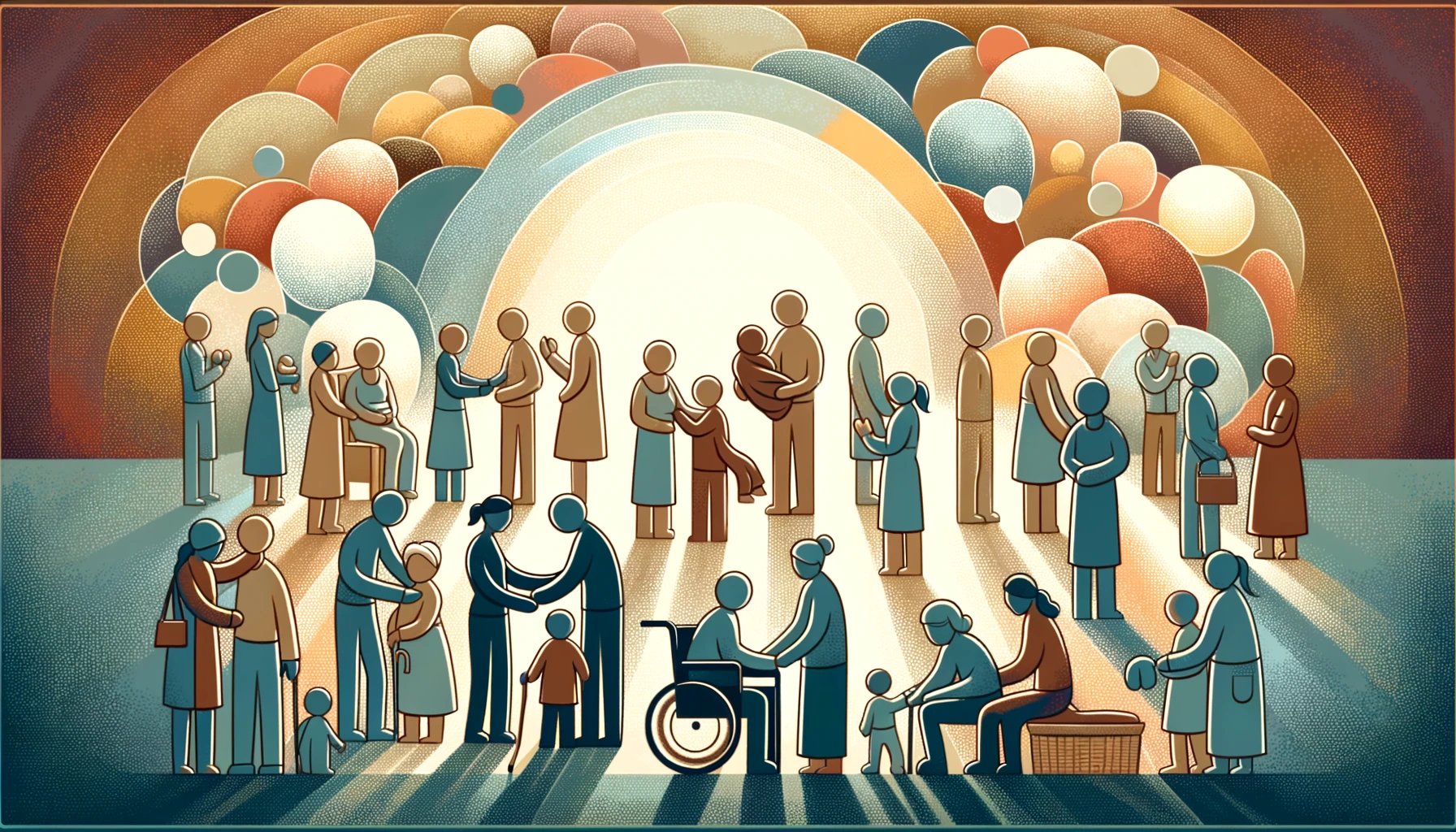
A Global Concern
“There are only four kinds of people in the world,” said the late Rosalynn Carter, former U.S. First Lady who founded the Rosalynn Carter Institute for Caregivers in 1987. “Those who have been caregivers. Those who are currently caregivers. Those who will be caregivers, and those who will need a caregiver.”1
Her statement certainly rings true today. With rising life expectancy, the global burden of diseases has increased up to 23% due to chronic and long-term health impairments among older adults. The burden is being passed on to their caregivers.2
Who Are Caregivers?
Studies suggest that informal caregiving contributes toward depressive symptoms as well as poor physical health, which may lead to suffering from impaired immune function and increased risk of mortality. 3
Caregiving can have adverse financial implications too, including lost wages and out-of-pocket costs that caregivers often incur for meals, transportation, medical supplies, toys, educational tools, home modifications, and more.4
Many countries have recognized the importance of informal caregivers’ services and have taken action to address their burden. Here are some examples.
The United States
In the United States, for example, more than 53 million people provide a broad range of assistance to support the health, quality of life and independence of someone close to them. Replacing their support with paid services would cost an estimated $470 billion each year.5 Caregivers with full or part-time employment face a unique set of obstacles. In fact, caregivers in the U.S. lose an estimated $522 billion in wages each year due to caregiving.
U.S. lawmakers addressed some of these issues with the Family and Medical Leave Act of 1993, which entitles eligible employees to take unpaid, job-protected leave for specified family and medical reasons with continuation of health insurance coverage.6
The Family and Medical Leave Act of 1993, which entitles eligible employees to take unpaid, job-protected leave for specified family and medical reasons with continuation of health insurance coverage.
And in 2018, the Recognize, Assist, Include, Support and Engage (RAISE) Family Caregivers Act directed the Secretary of Health and Human Services to develop a national family caregiving strategy. The law also directed the establishment of an advisory council to provide recommendations on effective models of both family caregiving and support to family caregivers.7
Recognizing that many informal or family caregivers lack medical training, Medicare now reimburses physicians and other qualified healthcare professionals for providing training to caregivers of people on Medicare.8
England
In England, the National Health Service offers several benefits to carers, including:
- Someone to take over caring so the primary caregiver can take a break (respite care).
- Gym membership and exercise classes to relieve stress.
- Help with taxi fares if necessary.
- Help with gardening and housework.
- Training on how to lift safely.
- Putting caregivers in touch with local support groups.9
The NHS also offers carer’s allowance and carer’s credit, i.e., a National Insurance contribution to ensure the carer retains social security benefits that otherwise might be lost due to gaps in an NI record.10
Asia
Boston Consulting Group’s 2022 Diversity and Inclusion Assessment for Leadership survey captured the experiences of some 9,000 employees of midsize to large companies in six Asia-Pacific countries (Australia, China, India, Indonesia, Japan, and Singapore).11 The statistics paint a picture of a potential caregiving—and economic-—crisis:
- Across the six countries studied, the number of employee-caregivers is expected to grow by 100 million to a total of 1.2 billion in 2035.
- The employee-caregivers in the survey were than 70% more likely than employees who are not caregivers to say that they are worried about their physical and mental well-being.
- Absent support to improve employee-caregivers’ well-being, the Asia-Pacific labor market could see increased numbers of caregivers leaving the workforce. The upcoming exodus in the six countries could cause a total GDP loss of $125 billion to $250 billion by 2035.
The survey data also revealed that each of the six countries display unique needs and require different means of support. What is consistent across them is the need for a holistic, employee-centric approach, comprising multiple programs and policies.
Japan
In Japan, a public long-term care (LTC) insurance system was initiated in 2000 and, as of 2016, approximately 18% of individuals aged ≥ 65 years were eligible. Although the Japanese LTC insurance system was introduced to relieve family caregiver burden, the country still depends heavily on informal family care at home.12
India
In traditional Indian as well as other South and Southeast Asian societies, co-residing family members are the primary source of caregiving, and filial piety is deeply rooted in social and cultural dimensions. The spouse is the primary caregiver along with the daughter-in-law. In the absence of a proper social security system, formal or paid care services for the elderly induces an economic burden for the care recipients and the family.13
Latin America
More than 8 million older people are dependent on long-term care in Latin America and the Caribbean. In this region, care dependence affects 12% of people over age 60 and almost 27% of people over age 80. Traditionally, this region’s main source of long-term care services has been unpaid, informal help, whether from families or friends. This role is primarily filled by women in families.14
- In Argentina, for example, 77% of people over age 60 who need care to perform basic activities of daily living regularly receive help from a family member, according to the National Survey on the Quality of Life of Older People.
- In Mexico, a 2014 survey found that women spend an average of 10 hours per week performing caregiving tasks and men seven.
- In Uruguay, a 2013 survey showed that 82% of care-dependent adults in need of help to complete their daily activities receive that help from unpaid caregivers: 58.9% from a family member living in the same home, 16.8% from a family member living elsewhere, and 6.3% from somebody outside the family. Women provide the unpaid assistance over 70% of the time.
Germany
Since the introduction of statutory long-term care insurance in Germany in 1995, the provision of informal care services can be supported by cash benefits or in-kind benefits. Currently, around 4.1 million people in Germany claim benefits from long-term care insurance. Most of the recipients receive outpatient care (about 3.3 million), 2.1 million are cared for at home by informal caregivers (mostly relatives), and around 818,000 people receive inpatient care.15
Acquiring and maintaining social support and social networks has been found to help alleviate caregivers’ psychological distress. Transmitting information on making better health and medical choices can increase their self-esteem and provide a sense of belonging and purpose in life.16
Indispensable
Caregivers around the world encounter significant mental, physical, and financial challenges, underscoring the need for substantial support. This piece sheds light on global efforts to ease these burdens, highlighting the indispensable role caregivers occupy in the healthcare ecosystem. By advocating for the recognition and support of these crucial figures, the narrative aligns with SEKISUI Diagnostics' mission to improve the health of all people whether it be through the products we provide to healthcare professionals or by highlighting the need to ensure caregivers get the tools they require to thrive.
References
- Promoting Caregiver Health, Strength and Resilience, Rosalynn Carter Institute For Caregivers, Rosalynn Carter Institute for Caregivers
- 2. Caregiving: a risk factor of poor health and depression among informal caregivers in India- A comparative analysis, BMC Public Health
- Ibid
- 2022 National Strategy to Support Family Caregivers, page 13, Administration for Community Living
- 5. RAISE Family Caregiving Advisory Council delivers report; recommendations for improving support to family caregivers, Administration for Community Living, Administration for Community Living
- Family and Medical Leave Act, U.S. Department of Labor
- RAISE Family Caregiving Advisory Council delivers report; recommendations for improving support to family caregivers, Administration for Community Living, Administration for Community Living
- CMS Adopts Codes for Caregiver Training Services, CodingIntel
- Carer’s Assessment, NHS
- Benefits for Carers, NHS
11. As Asia-Pacific Ages, a Caregiver Crisis Looms, BCG
12. The Association between Family Caregiver Burden and Subjective Well-Being and the Moderating Effect of Social Participation among Japanese Adults: A Cross-Sectional Study, Healthcare(Basel)
13. Caregiving: a risk factor of poor health and depression among informal caregivers in India- A comparative analysis, BMC Public Health
14. Gente Saludable, IDB Improving Lives
15. Informal caregivers in Germany – who are they and which risks and resources do they have?, Frontiers in Public Health
16. The Association between Family Caregiver Burden and Subjective Well-Being and the Moderating Effect of Social Participation among Japanese Adults: A Cross-Sectional Study, Healthcare(Basel)



Share Article